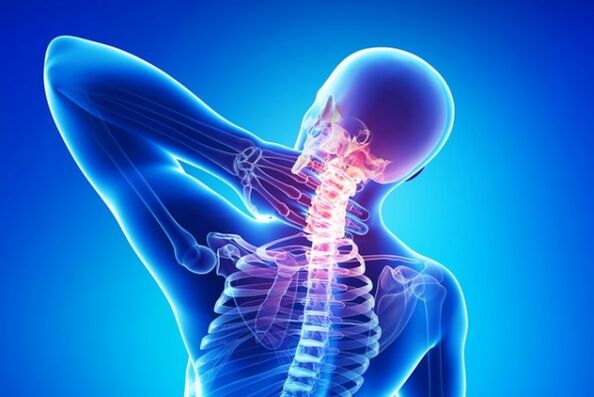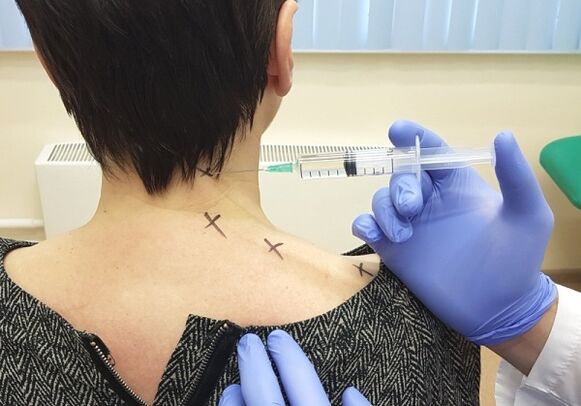Cervical spinal osteochondrosis is one of the most common types of osteochondrosis. It is indicated by the destruction of the disk and the adjacent vertebra. At the same time, the arteries and tips of the nerves are drawn into the pathological process. Recently, cervical osteochondrosis has become younger. If in the last century, the disease was an elderly man, today young people aged 23-40 suffer, maybe older. Such dystrophy accounts for up to 40% of the total pain.

Cause
Why does cervical osteochondrosis grow? It is proven that the most common cause of pathology is the lack of active movement. The work of sitting with the neck is extended forward or the head of the bow - this is how the office day of office workers and representatives of many other expertise. Arriving at home, the majority are sitting for a computer or TV. The same lifestyle leads to deterioration of blood flow to the spinal artery, followed by disc disk and vertebral destruction. The factors considered are far from the only cause of the disease. There are other causes of cervical osteochondrosis. For example, many experts attach to the hypothermia and weakness of the intervertebral joints, ligaments and muscles. The following factors are the initial mechanism for the development of neck osteochondrosis:
- disruption in the work of the endocrine system;
- flat feet;
- spinal injury;
- Posture violations;
- Unbalanced diet;
- High load on the cervical segment;
- autoimmune diseases;
- Viruses and infections.
In women of menopause, the cause of the progressive dysfunction of the cervical spine is a decrease in estrogen production with the development of equal osteoporosis.
Symptom
Symptoms of osteochondrosis can appear at the beginning of the disease and then, at a chronic stage. It all depends on the degree of distribution, the presence of the same pathology and a combination of bad conditions. The main symptoms of cervical spinal osteochondrosis:
- Hell hell;
- migraine, dizziness;
- neurotic disorders;
- pain and crisis in the neck;
- Weakness of the upper limbs:
- impaired sensitivity;
- worsening hearing and vision, movement coordination disorders;
- Loss of performance.
Pain for cervical osteochondrosis can give anywhere - on the shoulders, elbows, ears, under the shoulder blade. The unpleasant feature of the unpleasant sensation is the surprise. In acute attacks, discomfort disappeared as unexpectedly as it happened. Dizziness for neck osteochondrosis is often accompanied by disorientation, ear ring, loss of consciousness, nausea, migraine. The pressure spike occurs several times a day and cannot be cured with medical correction. Symptoms of damage to the cervical vertebra that occur in the brain are based on deterioration of blood flow and tissue trophism. As a result of compression of the spinal artery and oxygen starvation in the patient, the following disorders are indicated:
- fear and panic;
- irritation;
- invasion;
- frequent mood changes;
- tears;
- insomnia;
- worse memory and attention;
- An outbreak of anger outrage.
The signs of cervical osteochondrosis in women appear a bit earlier than in men and continue to be clearer. The first symptom of the disease, as a rule, is a brain disorder, often eliminated on PMS or hormone failure. Then there are dizziness, migraines, loss of consciousness. Symptoms of cervical osteochondrosis in men do not occur so intensively and often resemble angina pectoris attacks with shortness of breath, nausea, discomfort behind the sternum. Only experts can determine the true cause of such a manifestation, he or she will be able to provide the main help, so he cannot be postponed to his visit.
Degree
In view of and analyzes the procedure for the development of changes in vertebral tissue, doctors prescribe several stages of osteochondrosis of the cervical area:
- Clinical phase. The cervical osteochondrosis in the first stage is expressed by the displacement of the pulpoose nucleus to the side and the beginning of the destruction of fibrous rings. Pain during this period may not be present, small lordosis and difficulty in changing or tilting the head are possible.
- Osteochondrosis of the cervical area in the 2nd stage is characterized by increased pathological destruction, the entire instability of the segment with subluxis, and pain occurs, sometimes giving it to the shoulder or arm strap. Patients complain of disorders, memory deterioration and attention.
- Osteochondrosis of the 3rd degree develops with a complete rupture of the fibrous ring. Neurological symptoms arise, sensitivity is disrupted. The pain in the third stage becomes fixed and is very disturbing to the patient. The mobility of the cervical segment is getting worse.
- 4 degree neck osteochondrosis. The final stage of the degenerative process. The intervertebral disc is completely replaced by connective tissue, all symptoms become more noticeable, deterioration in movement coordination, ataxia is observed.

Depending on the localization of the pain, the following types of diseases are distinguished: and the cervix. According to the method, the disease is the custom to divide the acute intervertebrosis osteochondrosis of the neck, which appears for the first and chronic, stretching for years with remission and persistent severity.
Which doctor treats cervical osteochondrosis?
Various symptoms, often hiding under other diseases, cause patients to logical questions - which doctors will be contacted? When any pain in the neck, shoulders and hands or neurotic disorders occur, it is urgent to approach neurologists. And to whom to contact if there are no specialists like a local clinic? In this case, the ticket should be postponed to the therapist. The doctor will prescribe treatment or send a narrow specialization to the doctor.
Diagnostics
Diagnosis of cervical osteochondrosis begins with visual examination and patient survey. Neuropathologists are interested in the life and labor of the patient, the presence of chronic diseases, nutrition and motor activity. Early diagnosis is confirmed by instrumental research behavior:
- X -ray in two projections;
- MRI;
- Ct;
- Duplex scanning.
Hormone analysis is required for fairer sex. Without it, the treatment of cervical osteochondrosis in women does not begin. To exclude pathologies with such symptoms, differential diagnosis is made with the appointment of additional consultations with surgeons, gynecologists, cardiologists, eye experts and traditions.
Treatment
First aid for sharp pain in the cervical segment includes taking anesthetics and ensuring the entire affected area. Disruptive therapy - pepper pepper, applying ointment to help well. However, such measures cannot overcome the disease. They only temporarily simplify the patient's condition. Treatment for cervical spinal osteochondrosis is comprehensive. Its main goal is to eliminate pain and delay the destruction of disc and vertebra. For this, various types of therapies are prescribed: medicines, exercise therapy, massage, orthopedic collar. Treatment of cervical osteochondrosis in women has several features and is aimed at eliminating the symptoms of the brain. Another effective remedy for neck pain is physiotherapy. The treatment is prescribed both during severity and during forgiveness. The following procedure overcomes the symptoms of osteochondrosis:
- laser;
- magnetotherapy;
- ultrasound;
- Electrophoresis with novocaine or eufillin.
Is facilitating the patient's condition with therapeutic massage. Implement it only at the pardon level. To achieve continuous results, therapy is carried out by a course consisting of 9-10 procedures. Healing gymnastics is very effective for cervical area osteochondrosis. Strict loads quickly eliminate discomfort, increase vertebral mobility, strengthen muscles and increase blood flow. Often patients with osteochondrosis turn to recipes for traditional medicine, hoping to cure. Keep in mind that all non -traditional agents are only allowed in addition to the primary therapy prescribed by the doctor. Is it possible to fully cure cervical osteochondrosis? Unfortunately no. Other conservative drugs and methods can only suspend the dystrophic process and eliminate symptoms. Even after satisfactory therapy, the affected disc is still replaced by connective tissue and loss of their function.
Complication
Cervical spinal osteochondrosis is dangerous with complications. With the development of a bad disease, squeezing the spinal artery can lead to brain stroke, which continues to worsen hearing and vision. Often, hernia, severe hypertension and numbness or finger cooling -join osteochondrosis. In women, complications of neurological properties often develop - persistent fatigue, fatigue, loss of performance, excessive hatred.
Prevention

Prevention of cervical spinal osteochondrosis includes affordable physical activity, a balanced diet with adequate amounts of calcium and phosphorus, regulating weight and maintaining proper posture. All of the above should be a habit and a strict, better than childhood. Office workers and those who spend many hours behind the monitor screen to avoid neck osteochondrosis should adhere to simple suggestions:
- Each hour Managing a 10 -minute break where doing easy training;
- At lunch time, do not sit at work, but go walking in fresh air;
- Choose simple production furniture that does not include uncomfortable pose;
- Arrange a good table light.
After work days, it is recommended to lie on a flat surface without a pillow for 15-20 minutes or ask the household to do a lightweight massage. This will help relieve cervical muscle tension and relax. Excellent prevention of degenerative changes will not be a traumatic and swimming sport. Identified and cured osteochondrosis in the cervical region may not be clear for years, allowing patients to live a true life. And with the usual preventive administration used for the prevention and treatment of drug osteoarthritis, the disease will stop disrupting even in old age.



















